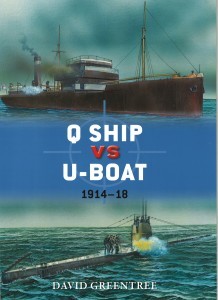 By David Greentree, Osprey Publishing, New York, NY (2014)
By David Greentree, Osprey Publishing, New York, NY (2014)
Reviewed by Sam Craghead
With its dependency on merchant ship deliveries, the success of German U-Boats caused grave danger to Great Britain’s lifeline of food and supplies. Created as a countermeasure to the German submarines during World War I, service on a Q Ship became one of the most dangerous and unusual assignments for sailors of the Royal Navy.
Prior to the outbreak of war, the submarine was not considered a threat to commerce. The great nations had not developed or even considered how to counter the submarine. The idea that a civilized nation would attack civilian ships and leave the survivors to their fate was unthinkable. Therefore, it was not a factor when planning for a war that included the submarine as a new weapon.
The British viewed the submarine as a coast defense weapon. The Germans saw the U-Boat as a weapon for fleet action or as a way to attack enemy warships. Different classes of U-Boats were in operation during the war. Their construction, crew size, armament, and cruising range varied.
At the beginning of 1914, German policy and procedure was formulaic. The submarine, following prize law, would surface and stop the ship. They would then check their cargo for contraband of war and then attend to the safe transfer to lifeboats for the crew and passengers before sinking the vessel. The all hinged on a ship to be a legitimate prize of war. If the ship did not prove to be a legitimate prize, it was released.
Desperate situations call for desperate measures. This phrase certainly characterizes the life of the men who manned a Q Ship. To lure an unsuspecting enemy submarine to attack, the crew would man the lifeboats as if the order to “Abandon Ship” was given. The boat would pull away from the ship, enticing the U-Boat crew to let their guard down and approach the “helpless” vessel. If the U-Boat was not in range or in a favorable position for weapons, the crew of the Q Ship might come under gunfire or torpedo attack until the U-Boat could be engaged. The Q Ship’s crew would then unmask their weapons and open fire on the enemy.
Q Ships were crewed by officers and men from the Royal Navy, the Royal Naval Reserve, merchant sailors, and volunteers. All underwent exacting training to handle the weapons and to act the part of less than well-trained sailors. They had to be convincing while mimicking the panic of a merchant ship crew encountering an enemy submarine. They dressed and acted like civilians manning a civilian vessel. A Q Boat crewman possessed what might be termed as “raw nerve.”
As a commissioned Royal Navy ship, the Q Ship operated under international law. The ship was allowed to fly a “false flag” which had to be replaced by the national ensign before firing upon an enemy. The Q Ships, also called “Mystery Ships,” were converted steam trawlers, fishing smacks, schooners, and so-called “three-island tramp steamers” (which displaced between 1,000 and 5,000 GRT and made up the majority of the cargo ship types operating in and near British waters). Ships were modified to conceal armaments, including a variety of weapons. Machine guns, 12 and 6-pounders, and torpedoes were common. Special mountings were designed to enable the weapons to be hidden and then quickly brought into action.
The Q-Ships best record during the First World War was occupied from 1914 to 1917 when the Kaiser ordered unrestricted submarine warfare. Of the 187 U-Boats lost during the war, only seven percent were credited to the Q Ships. However, Q Ships were responsible for damaging approximately sixty U-Boats.
While the operations of Q Ships may be familiar to those well versed in the war at sea during The Great War, David Greentree has written a book of much interest to historical readers. This book is well documented and contains excellent graphics and photographs. This book should be on the reading list for the student new to the subject of the war, as well as to those with an interest in the War at Sea.
Sam Craghead is a historian with the Museum of the Confederacy in Richmond, Virginia.

